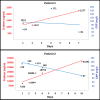D-dimer and C-reactive Protein Blood Levels Over Time Used to Predict Pulmonary Embolism in Two COVID-19 Patients
- PMID: 32523928
- PMCID: PMC7279916
- DOI: 10.12890/2020_001725
D-dimer and C-reactive Protein Blood Levels Over Time Used to Predict Pulmonary Embolism in Two COVID-19 Patients
Abstract
The diagnosis of pulmonary embolism is challenging in symptomatic COVID-19 patients since shortness of breath, chest pain, tachycardia, tachypnoea, fever, oxygen desaturation and high D-dimer blood levels might be features of both diseases. We present two COVID-19 patients in whom pulmonary embolism was suspected (and diagnosed) due to a discrepancy between an increase in D-dimer blood levels and a decrease in C-reactive protein blood levels over time. We believe that an opposite change in the blood levels of both biomarkers over time may be used as a novel method to predict pulmonary embolism in COVID-19 patients.
Learning points: The diagnosis of pulmonary embolism is challenging in COVID-19 patients since symptoms, signs and high D-dimer blood levels might be similar in both diseases.An increase in D-dimer blood levels and a decrease in C-reactive protein blood levels over time may be used as a novel method to predict pulmonary embolism in COVID-19 patients.
Keywords: C-reactive protein; COVID-19; D-dimer; pulmonary embolism.
© EFIM 2020.
Conflict of interest statement
Conflicts of Interests: The Authors declare that there are no competing interests.
Figures
References
-
- Zhai Z, Li C, Chen Y, Gerotziafas G, Zhang Z, Wan J, et al. Prevention Treatment of VTE Associated with COVID-19 Infection Consensus Statement Group. Prevention and treatment of venous thromboembolism associated with coronavirus disease 2019 infection: a consensus statement before guidelines. Thromb Haemost. 2020 Apr 21; doi: 10.1055/s-0040-1710019. [Epub ahead of print] - DOI - PMC - PubMed
LinkOut - more resources
Full Text Sources
Research Materials


